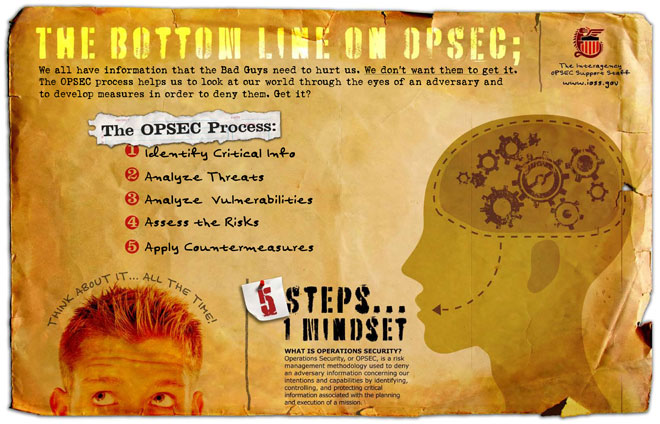Understanding Personal Security
- Improving the Last Line -
Last Line of Defense
None of us will live a perfectly safe life, if you think otherwise I’m sorry but it’s just not going to work out that way. The world we live in is a dangerous one and the risks we face are different depending on who we are and where we are. Protecting yourself is your own responsibility. No matter how good the police and security services are in your city and country, when a threat comes your way you are your own last line of defense. Ensuring your own security is known as Personal Security, or PERSEC, and here’s a few core concepts for how you can improve your own from Gecko Professional Services.
Tune Your Situational Awareness
Situational Awareness is a tough skill to develop.
Situational Awareness is an easy skill to develop.
No, you’re not going crazy. You actually did read both of those sentences correctly and both are true.
The basics of situational awareness are simple: keep your eyes open and scanning for threats, be aware of changes to your environment, learn to use all of your senses- don’t just look, you can also find threats from what you hear, smell, and feel. You have so many ways to find threats with the senses you have naturally, but that doesn’t mean you’re being truly aware. If you don’t know what to look for, you’ll most likely look past a threat without ever recognizing it. You have to be able to process the information you obtain from your senses and decide what is and is not a threat.
Is that motorcycle that took the same two turns as me, is it just taking the same route or is it following me? The guy who keeps playing with the bottom of his shirt, is he just scratching himself or is he adjusting the weapon he keeps at his waist? The car with a tarp covering the back seat sitting in a no parking zone, is it someone who parked in a hurry or is there a bomb inside?
These are real situations people face and these are situations from which people have faced real threats as well. Determining what is and is not a threat and having good situational awareness requires skills which can be gained from training and experience. A good first step toward improving your personal security: be aware of local crime trends or the tactics of regional terrorist attacks. Find out what is targeted, the methods of criminal acts, and where these incidents take place. This will let you know what you should protect, what you should look for, and where you should be especially aware. Another good tool, take a class or read a good book on body language and learn to interpret aggressive or unusually nervous body language. This may be the first sign of an attack or incident which is about to unfold.
In summary; situational awareness is about more than just looking, it’s about knowing what to look for.
Be the Gray Man
Your 5.11 pants and “operator” hat aren’t helping you. Yes, I’m talking to you [insert the name of any government contractor I’ve ever see on a transatlantic flight]. An important piece of staying safe is preventing yourself from becoming a target, this means blend in as much as you can. When you’re in the slums of Brazil, take off the $100 t-shirt and $500 watch, when you’re in an upscale European shopping district pick something other than cargo shorts and a baseball cap. Both of these may sound ridiculous, but I’ve also seen both (and the Brazil story doesn’t end well) and each of these made the person stand out in a crowd. If there’s a criminal nearby, their target is now a clear one.
If you’re in the area you live in, be yourself. Act as normal as you desire and you’ll, generally speaking, fit right in. When you’re travelling, fit in with the locals as much as practical. This doesn’t mean to find the most traditional clothing to go out on the street, but see what people who look most like you look like in this part of the world. Look at what they wear, what kind of body language they display, and how they interact with each other. If this doesn’t make sense, it will when you travel to an area where the people don’t all look and act anything like you. When I lived in a Middle Eastern country for example, I looked at what the other white guys living there did. This mostly meant people working for local companies or as aid workers or teachers, I worked to fit in with them and not make it obvious that I was the temporary visitor with a pocket full of cash. In this area it meant I pulled out some older shoes, bought some off brand jeans at a local market, grew a bit of facial hair, and wore collared shirts without a big brand name or logo. This sounds simple, and it is, but I know that when I left I was never the victim of a crime while other people I knew and worked with who maintained their American and European style had been- and this was the case while I was often travelling into more dangerous areas than them.
In addition to how you look and act be aware of what is going on in the area you’re in. Keep up with local news and politics, stay clear of political demonstrations, and avoid large public gatherings whenever possible. For public events, be careful of any that fall on national or religious holidays and whenever possible avoid going to them or near them at the busiest times.
To be the “gray man” and prevent yourself from being a bigger target, do what you can to fit in and avoid high risk areas.
Train to Win
Prepare. Learn. Practice.
Prepare to confront a threat by having the necessary tools, the part of the world you live in will determine what kind of tools these are (this means you must be aware of what tools and tactics are practical and which are legal, be aware of and follow all relevant laws). In some areas it may mean a concealed pistol or even a visible rifle, in other parts of the world it may mean a heavy weight defensive pen or a pepper spray. Other tools such as a taser, knife (a good utility tool, but also a very personal and violent means of self-defense so be wary of it), or collapsing baton are also common for self-defense. In addition to these, a first aid kit is also a good tool to have. These are all important to being prepared for being at the receiving end of a criminal act or threat of some sort.
No matter what tools you have though, you must learn how to use them. This means take firearms training, certification classes for tools you use, self-defense techniques course, or whatever other relevant training you can find. Medical training can be especially important as these lifesaving techniques can be necessary in everyday life. You never know what will help you. Learning to improve your situational awareness can also be good, this may be done in a surveillance or counter-surveillance course, a class on body language or behavior detection, or keeping close tabs on local crime trends through news or press alerts from a police department.
Having these tools doesn’t help much if you don’t practice them though. Some tools such as situational awareness can be practiced in everyday life while others can be practiced only at through classes, reviewing training materials, or going to a shooting range. Whatever the tools you choose, make sure you learn how to use them and don’t forget how to use them.
In the end you must remember, keeping yourself safe and secure is your own responsibility.



